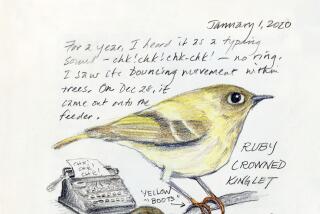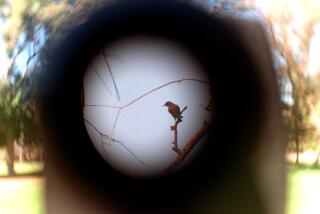A Little Birdie Told Them
Often beguiling, sometimes raucous, the sounds of birds have inspired a surprising variety of musical compositions during the centuries, according to a San Francisco ornithologist who has studied the convergence of themes in bird song and music.
From Mozart and Beethoven in the salons of Europe to indigenous tribal musicians in the tropical jungles, appreciative students of bird songs have incorporated them into their work.
In some cases, snippets from a bird song are clearly recognizable in the musical composition, said Luis F. Baptista, chairman of the department of ornithology and mammalogy at the California Academy of Sciences.
Baptista’s fascination with the intersection between the sounds of nature and the sounds of music is aesthetic and scientific. He and other researchers have been trying to understand the transmission of bird sounds from one avian generation to the next. In doing so, they’ve gained an intriguing glimpse into the ways in which birds and humans create music.
“As composers, birds often use the same rhythmic variations, pitch relationships, permutations and combinations of notes as found in music so that some bird songs resemble musical compositions,” wrote Baptista and Robin Keister of UC Davis in a paper presented recently at a meeting of the American Assn. for the Advancement of Science. “And they often vary themes in much the same way as humans.”
Baptista said some bird songs have been found to use the same eight-note scale as Western music. Others use a five-note scale common to Chinese music. That may be one reason humans find the bird songs attractive, he said.
Many indigenous peoples use bird song in their compositions, according to Baptista and Keister. Tribal elders of the Koyukon people in northern Alaska adapt the song of the loon in their music. A tribe in Costa Rica reproduces the song of the riverside wren with flutes. Shamans of the Tuvian people of central Asia are said to imitate the raven’s call in their healing rituals.
As for Western music, several researchers have concluded that Beethoven borrowed the opening phrases of the rondo in his violin concerto from the European blackbird.
Perhaps the most interesting case of bird borrowing has been attributed to Mozart. He bought a pet starling on May 27, 1784, and kept it for three years, until its death. Mozart, who was delighted by the bird, had it buried with graveside hymns. He also wrote a poem in its honor.
In a paper published a decade ago in the journal American Scientist, psychologists Meredith West and Andrew King described the song motifs of starlings, their penchant for mimicry of human speech and the close bond they form with caregivers.
Eight days after Mozart’s starling died, he wrote a piece called “A Musical Joke” (K. 522). The first movement includes a section that one record-jacket essay describes as an “awkward, unproportional and illogical piecing together of uninspired material.” Later in the piece, it says, there is a “grotesque cadenza which goes on far too long and pretentiously ends with a comical deep pizzicato note.”
Some analysts have said “A Musical Joke” was meant as a caricature of the popular music of Mozart’s day. West and King proposed instead that sections of the piece mimic the song of starlings, with their propensity to intertwine whistled tunes.
Whatever the provenance of the Mozart piece, other composers have paid homage to avian vocalists. Vivaldi wrote a flute concerto called “Il Gardellino,” named after and inspired by the goldfinch. Respighi’s “Fountains of Rome” uses the song of a European nightingale as part of the composition.
Even the familiar sound of a woodpecker, said Baptista, can have subtle musical overtones. At Yuba Pass, Calif., he studied a Williamson’s sapsucker that drummed on sites on three different snags to produce seven different tonal qualities and pitches. When another woodpecker produced a low-pitched drum, the woodpecker understudy jumped to the appropriate log to make an answering sound that matched his neighbor’s.
A Socorro mockingbird of Mexico will sing a long series of short themes. Its immediate neighbor will respond to each theme with an identical theme. March wrens in California may sing as many as 150 song themes in a fixed sequence, each matched by a neighbor in a leader-follower role.
Musical composers have employed similar devices. Baptista said the simple melodic canon--a melody followed by an identical melody before the initial statement is finished--is used in Haydn’s Echo divertimento (No. 5, in E flat). One ensemble plays a motif and a second ensemble responds with an identical passage.
Baptista finds some parallels in the manner by which vocal traditions are passed on by birds and humans. While conducting field work on birds in Papua New Guinea, he once was invited to participate in a special ceremony at one of the local villages. A man taught verses of a native song to his eldest son, and the pair then led the village in singing.
The transmission of song from one generation to the next is also seen in several species of Darwin’s finches, Baptista said. Male finches learn their songs directly from their fathers, with any idiosyncrasy in the father’s song turning up in the song of the juvenile bird as well.
More to Read
The biggest entertainment stories
Get our big stories about Hollywood, film, television, music, arts, culture and more right in your inbox as soon as they publish.
You may occasionally receive promotional content from the Los Angeles Times.










